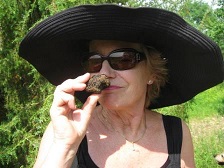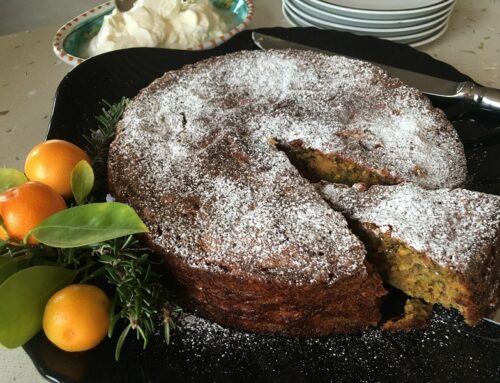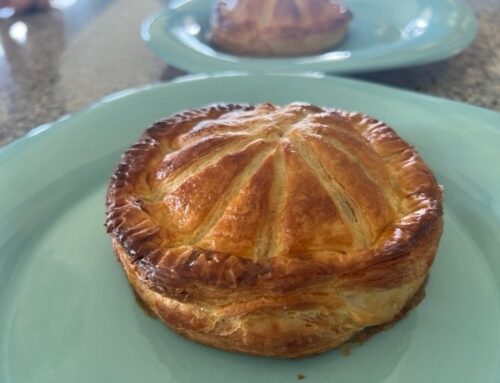One of the world’s most expensive foods is the truffle. Truffle hunting – called le cavage – was always one part of our week’s program at la Combe en Périgord. Nearby to our village of Les Eyzies, is a tiny village called Pechalifour, where Edouard Aynaud, the trufficulteur, lives on his truffle farm, Truffe en Périgord. During our visit, he presented an interesting talk about truffles in general, and then he took us truffle hunting with his labrador.
Truffles are the highly fragrant subterranean fungus that grows symbiotically with the roots of certain trees. In Perigord the trees are almost always oak, and that was the case with Edouard’s trees; other trees include chestnut, hazelnut, evergreen oaks, birch, beech, poplar. These Perigordian oak trees like to grow in dry, stoney soil, Jurassic soil, with an alkaline of ph8.
As we visited in July, it was summer, so the truffles we found were ‘summer truffles’ which are also black on the outside, but white inside; they are less expensive than the black truffle, known as Tuber melanosporum….the ‘black diamond of the kitchen’ as described by renowned French chef, Brillat-Savarin.
The winter black truffles sell for 1000 euros a kilo, and in the weeks before Christmas they escalate and sell for 1200 euros! – summer truffles sell for less, around 150 euros a kilo; this is small compared with the ‘Queen of Truffles’ from Piedmont in Italy where they sell for 4000 euros a kilo. The largest truffle found to date weighed in around 3.3lbs – about 1.5kg and cost $330,00.
There is a huge international black market for truffles also. Edouard tells us about unscrupulous wholesalers who will set out the Perigord truffles for buyers, then fill the order with cheap Chinese truffles that may have been frozen and can be full of maggots.
Also, almost all the truffle oil sold is concocted by mixing a synthesised aromatic hydrocarbon with olive oil. Very little oil that is labelled “truffle oil” actually comes from truffles!
Truffle hunting is very difficult procedure as the truffles grow 5- 10 cm underground and cannot be seen. It requires the services of a well trained dog to hunt for them and the dogs do this by scent. This used to be performed by pigs, nowadays it is mainly dogs. When searching for truffles, some indications of their presence is a ‘burn’ around the tree or a swarm of flies, seen when the ground is tapped and they fly in a circle above the area, which alerts the trufficulteur to their possible location; however, flies often are a bad sign for finding good truffles, as they lay eggs and the maggots eat the truffles.
Edouard took his Labrador, on the leash, and headed for the oak grove, with his bags for the truffles and the treats for the dog. He instructs the dog to ‘cherche, cherche’ –search, search – and the dog with his nose to the ground, scents the earth searching for the smell that will indicate the presence of the truffle. When the dog starts to paw the ground and dig, indicating that he has found something, Edouard gently pushes the dog away and scratches carefully with his blade, around the spot, to see if the truffle is large enough to gather. Many we found were too small and so were recovered to harvest another time. Once the truffle is unearthed gathered, the dog will have his reward, a cheese, or meat treat – both the dog and the trufficulteur are happy
More about Truffles – ‘the fungus of the gods’
Truffles are one of the most expensive foods in the world. Brillat- Savarin, the renowned French chef described the black truffle as ‘black diamond of the kitchen’. They are a type of fungus, and so a not-too-distant relative of mushrooms. There are quite a few varieties of truffle, all in the genus Tuber. The best known varieties are the black truffles found in the Périgord region of France, tuber melanosporum, and the Italian white truffle, tuber magnatum.
Truffles look like small knobbly lumps, about the size of a walnut, although some are much smaller and others gigantic, weighing a kilogram or more. They have a distinctive, pungent odour, which is sometimes referred to as ‘earthy’, ‘garlicky’, ‘nutty’ or ‘musky’. Cut a slice from one of the hard clumps and you’ll see tiny white veins running through the otherwise solid interior. However, the look and the smell are secondary to the taste, which is generally is considered heavenly.
Because of their high price and their pungent taste, truffles are usually served sparingly, such as very finely shaved over an omelette, a salad, over scallops, pastas, infused into a salad dressing or mixed into foie gras or pâté. Black paper-thin truffle slices may be inserted into meats, under the skins of roasted fowl, or in stuffings. Some speciality cheeses contain truffles as well. Black truffles, by the way, release more aroma when heated, whereas heat destroys the flavour of white truffles, so these are served raw. Be careful to match your recipe to the available truffle varieties.
The reasons truffles are so expensive is that they’re hard to cultivate, find and store. They grow under a few inches of soil on the roots of certain trees—mainly oak, but sometimes chestnut, hazelnut, and others. The only way to locate them reliably is by smell, but this requires a nose that is both sensitive and located closer to the ground than the human nose. Pigs are widely regarded as having the best nose for truffles, and are sometimes used to hunt them. The difficulty with pigs, however, is that they are passionately fond of the taste of truffles and like to eat them. This is due to a compound within the truffle similar to androstenol, the sex pheromone of boar saliva, to which the sow is keenly attracted! So it can be tricky, and dangerous, to get between the snout of a pig and a truffle it’s trying to dig up!
Now certain breeds of dogs are most commonly used to hunt for truffles; after a certain training period, they are effective finding truffles, less likely to eat them than pigs, and easier to restrain if they try. There is also a third common method of locating truffles and this relies on a still smaller animal: the Suillia fly. This insect likes to lay its eggs above truffles, so if you can spot one flying close to the ground, it’s a good bet there are truffles nearby.
Truffles grow only in autumn and winter, and only in a very few regions where temperatures and rainfall are just right. In France, for black truffles, the growing season runs from November to March; for white truffles, it’s generally September to early January. Although France is reputed to have the best black truffles and Italy, the best white truffles, they also grow in other parts of the world, including the west coast of North America, from northern California through British Columbia, and in Australia
Another reason for their expense is that they are difficult to store. They loose their flavour quickly after harvesting and so are at their best when consumed fresh. However, it is possible to freeze them and to preserve them, in a light brine, in cans or jars. This enables them to be available out of season; however the experts agree that it’s best to consume them within a few days after they’re removed from the ground.
Interestingly, truffles have long been considered an aphrodisiac. Black truffles contain 5-alpha-androstenol, a sex hormone related to testosterone that is also found in the underarm perspiration of human males and the urine of human females. Many people believe that this very same hormone may explain the strong attraction pigs have for truffles, but experiments have shown that another chemical, dimethyl sulfide, is more likely what the pigs find interesting.
White truffle ‘Alba madonna’, Tuber magnatum, comes from the Langhe area of the Piedmont region in northern Italy and, most famously, in the countryside around the city of Alba. Growing symbiotically with oak, hazel, poplar and beech and fruiting in autumn, they can reach 12 cm diameter and 500 g, though are usually much smaller. The flesh is pale cream or brown with white marbling. Like the French black truffles, Italian white truffles are very highly esteemed. At the white truffle market in Alba, the busiest months are October and November, with the Truffle Festival held in November each year. As at December 2009 the white truffles were being sold at €10,200 per kilogram.
The “Chinese truffle” (Tuber sinensis, also sometimes called Tuber indicum) is a winter black truffle harvested in China. Due to their bountiful growth, Chinese truffles are often exported to the West as an inferior-quality substitute of Tuber melanosporum. Some truffle exporters or delicatessen shops sell Chinese truffles into which extracts of the real Tuber melanosporum are introduced. These truffles are often sold at a high price, marked as Tuber melanosporum.
In Australia, truffles are grown in Tasmania, Western Australia, Australian Capitol Territory and are now, in Victoria, truffle inoculated oak trees are being sold via the internet from Sommerville.
In 1999, the first Australian truffles were harvested in Tasmania, the result of eight years of work. Trees were inoculated with the truffle fungus in the hope of creating a local truffle industry. Their success and the value of the resulting truffles has encouraged a small industry to develop. A Western Australian venture, the Wine and Truffle Company, had its first harvest in 2004, and in 2005 they unearthed a 1 kg truffle.
In 2008, an estimated 600 kilograms of truffles were removed from the rich ground of Manjimup, Western Australia. Each year the Wine and Truffle Company has expanded their production, moving into the colder regions of Victoria and New South Wales.
Rivalry and competition between growers in the states of Tasmania and Western Australia appear to be intensifying. In June 2010, Tasmanian growers Michael and Gwyneth Williams harvested Australia’s largest truffle from their property at Myrtle Bank, near Launceston. It weighed in at 1.084 kilograms and is valued at approximately AUS$1,500 per kilo.
There are now many trufferies planted in Australia, including Victoria and New South Wales.
- The truffle we found, or rather the dog did
- Hunting….
- The aroma is wonderful, earthy and rich









